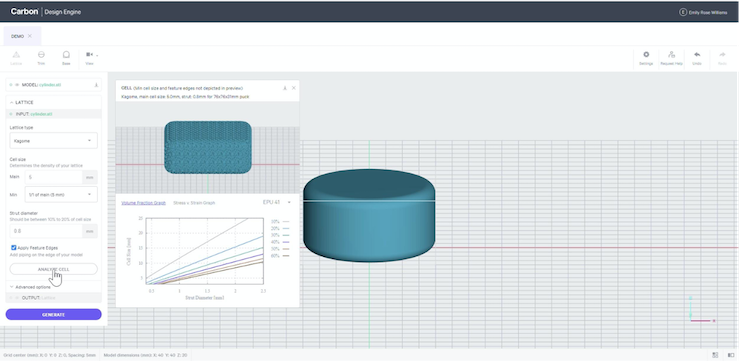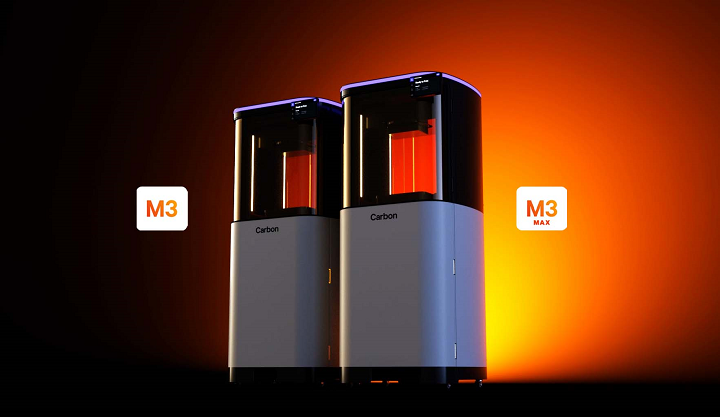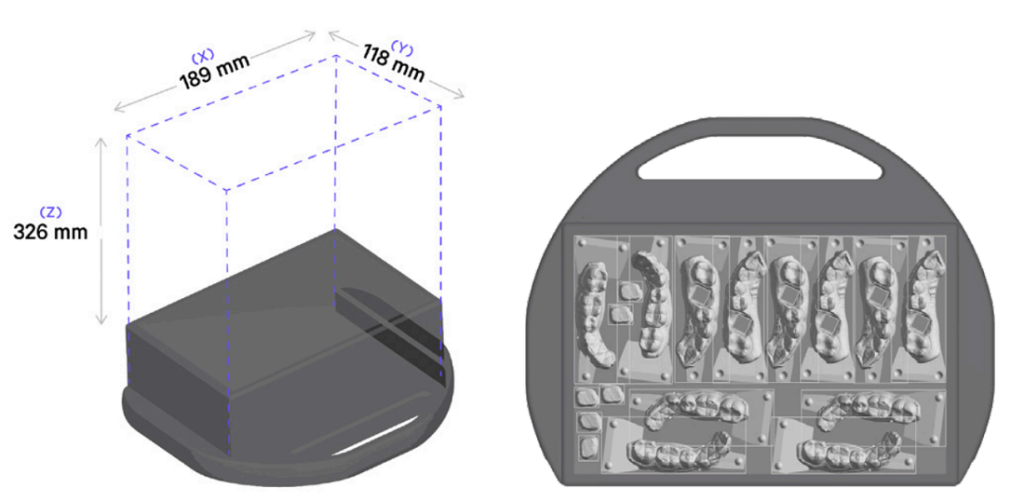It’s been a few years since Carbon introduced a new 3D printer, as the M2 was launched in 2017 and the L1 came in 2019. But, today, the 3D printing unicorn announced the next generation of its innovative Digital Light Synthesis (DLS) technology, which has been used often to make products for the consumer and sporting goods industries. As Phil DeSimone, Carbon’s Co-Founder and Chief Product & Business Development Officer, said in a press conference yesterday, the next generation M Series is “not just about a new product,” but a platform that can “empower people everywhere to make what the world needs right now.”
The new DLS systems, the M3 and M3 Max, are said to be smarter, smoother, faster, and simpler, delivering more throughput and consistency, better surface finish, and larger build volumes.
“We’re really excited about the news we have to share today. Since Carbon’s inception, we’ve taken pride in pioneering technology that brings AM to the masses,” DeSimone said.
Joined by Carbon’s Head of Communications, Kristalle Cooks, and Rob L’Heureux, Director of Product Marketing for Carbon, DeSimone explained that the software is what’s really “at the heart of the DLS process,” offering a “true digital thread with built-in quality assurance all the way through.”
He went on to explain that great materials are also critically important to making great products, no matter how fast your printer is, and reminded the assembled journalists on the Zoom call that Carbon released support for four new materials in 2021 alone, with another one coming next month.
“But you all didn’t join us today to hear an update about how things are going here,” DeSimone continued. “At Carbon, we’re always pushing the envelope, and today we’re excited to show you something totally new with the all new M3 and M3 Max.”
L’Heureux chimed in, noting that this new generation of DLS ” further address requirements for customers to take advantage of additive manufacturing,” and that these new printers are “ideal” for any customers that want simpler but faster printing. Plus, it sounds like the M3 and M3 Max offer more in the way of print volume as well.
“The M3 Max offers the same benefits as the M3, but with double the build area,” he said, before continuing that “parts that print well on the M2 will print great on these next-generation printers.”
They explained that the build volume of the M3, which is 189 x 118 x 326 mm, is consistent with the M2, but the M3 Max, with a 307 x 163 x 326 mm build volume, is doubled in the X and Y axes, with the same Z axis. However, the M3 Max has the same pixel size and density as the M3 printer, which makes it good for printing larger parts or many smaller parts with similar quality. This is due to a new feature: L’Heureux said that the M3 Max has “a true 4K chip, which we believe will have an impact on part quality,” with DeSimone stating that it’s the “first 3D printer to incorporate a 4k DLP light engine,” which is “unbelievably unique.”
“In terms of the resolution, the M2 and the M3 have the same pixel size,” DeSimone said. “But if we took the 4K light engine and kept it to the M3 build envelope, you’d have smaller pixels. But we were able to maintain the same pixel size as the M2 and M3 for the M3 Max, with two times the throughput.”
This 4K light engine is what enables twice the build area with the same pixel size and density.
The M3, said to be up to 2.5 times faster than the M2, was built for fast printing, and Carbon explained in a press release that better infrared-based resin heat management allows the two new DLS systems to offer more throughput per square foot in scenarios that are “thermally limited.” The smaller of the two, the M3, is also said to offer a larger design space, a simpler print experience, and a more consistent surface finish. The company said that its next-generation DLS printers enjoy a broader design space, which allows them to print more geometries that previous systems could not, especially for elastomeric parts and ones with features that are sensitive to high forces.
Speaking of lower forces, DeSimone explained that the M3 and M3 Max have highly sensitive sensors in the build arm, which can feel suction forces in real time and then relay them back to the printer itself, which will then either speed up or slow down so customers can optimize their prints and “make sure that they’re getting the quality of the part after the build that they’re looking for.” With these much lower forces, it’s possible to print green parts, and they also introduce closed loop control of temperature and force, which can decrease failure modes and make the overall printing experience much simpler.
The company also says that its new DLS systems can produce much smoother parts, with tests showing a 1.4 µm reduction in surface roughness than earlier generation DLS printers, and that they decrease part variations across a build by up to 50%, which means more accurate, repeatable parts.
DeSimone brought up another of the M3’s “more compelling features,” namely that it’s the company’s first printer that customers can install themselves.
“Installing equipment after it’s been shipped is a difficult thing to control, so a lot of expertise went into making this possible,” he explained. “Customers can expect the highly consistent and accurate 3D printing experience that Carbon’s DLS has offered since day one. The calibration takes care of itself.”
The company designed the M3 so that it can be installed in just a few hours, and so that customers can quickly and easily relocate the system in their facilities if and when they want.
“Fast Radius uses Carbon’s printers and materials to produce parts for a wide range of customers, across varying applications. We’ve also leveraged the Carbon Design Engine—in conjunction with our own software capabilities—to help customers evaluate materials and technologies to produce parts that exceed quality standards and timelines,” Bobby Bott, VP of Manufacturing at Fast Radius, a Carbon Partner and customer, said in the press release. “Having worked with Carbon for five years, we are thrilled to continue our partnership and bring the M3 capabilities to our customers.”

The Carbon Design Engine is able to anticipate the performance of a lattice design before it is generated. In this instance, parameters are suggested to produce a model to lower the weight of the part.
A new touchscreen interface offers more functionality to the printers, with other features including next-gen oxygen permeable optics, better ergonomics, visual and audio status notifications, and 30% less cross-build variability. Plus, they both work with a variety of high-performance materials meant for applications in multiple industries, including automotive, dental, consumer products, industrial, and life sciences. In response to a question in the chat, DeSimone said that rather than targeting new industries with the M3 and M3 Max, the next generation printers are “meant to improve the experience for all the audiences Carbon already sells to, from oral health to automotive.”
“Customers in consumer product areas, like ones with elastomeric lattices, should be able to prototype more easily,” he said.
“We now also have a printer at every price point for dental labs, so these give us a better, more robust product portfolio than we historically had.”
Speaking of price, DeSimone said that M2 customers can easily upgrade to the M3 or M3 Max, which use the same print preparation software, with Carbon’s subscription program. All you need to do is reach out to your account manager if you’d like to upgrade your system. Because of this subscription program, DeSimone and L’Heureux were hesitant to name a specific price for the new printers, noting that costs will be shared directly with customers.
Additional specs for the M3 include:
- XY resolution of 75 μm, Z resolution of 50 or 100 μm
- Accurate up to ±65 μm + 1 μm per mm dimension size
- Up to ±37 μm production repeatability
- 90+% dental accuracy within ±50 μm
The new Carbon M3 and M3 Max are both available for order right now, though the M3 Max isn’t expected to ship until the second half of 2022.
Subscribe to Our Email Newsletter
Stay up-to-date on all the latest news from the 3D printing industry and receive information and offers from third party vendors.
Print Services
Upload your 3D Models and get them printed quickly and efficiently.
You May Also Like
Reinventing Reindustrialization: Why NAVWAR Project Manager Spencer Koroly Invented a Made-in-America 3D Printer
It has become virtually impossible to regularly follow additive manufacturing (AM) industry news and not stumble across the term “defense industrial base” (DIB), a concept encompassing all the many diverse...
Inside The Barnes Global Advisors’ Vision for a Stronger AM Ecosystem
As additive manufacturing (AM) continues to revolutionize the industrial landscape, Pittsburgh-based consultancy The Barnes Global Advisors (TBGA) is helping shape what that future looks like. As the largest independent AM...
Ruggedized: How USMC Innovation Officer Matt Pine Navigates 3D Printing in the Military
Disclaimer: Matt Pine’s views are not the views of the Department of Defense nor the U.S. Marine Corps Throughout this decade thus far, the military’s adoption of additive manufacturing (AM)...
U.S. Congress Calls Out 3D Printing in Proposal for Commercial Reserve Manufacturing Network
Last week, the U.S. House of Representatives’ Appropriations Committee moved the FY 2026 defense bill forward to the House floor. Included in the legislation is a $131 million proposal for...







































